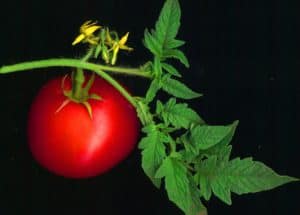
16
JunIn Search of the Perfect Tomato
 For the first time in over two months, my husband and I are able to eat dinner at the kitchen table. Since March, nearly every flat surface in the house has been completely covered in seedlings. While I devoted a fair amount of counter space to peppers, strawberries, pumpkins, and the like, it is really the dozen varieties of tomatoes that have taken over our house and my life.
For the first time in over two months, my husband and I are able to eat dinner at the kitchen table. Since March, nearly every flat surface in the house has been completely covered in seedlings. While I devoted a fair amount of counter space to peppers, strawberries, pumpkins, and the like, it is really the dozen varieties of tomatoes that have taken over our house and my life.
As an adult, I have always had a garden of some kind, but in the past few growing seasons, things have gotten a little out of hand. After having poor results in the little plot in the back of our yard, I moved my entire garden to containers on our patio. Twenty giant pots yielded enough beans, peppers, tomatoes, peas, strawberries, cucumbers, and herbs for us to eat like kings all summer, but I still wanted more. So last fall, my father-in-law and I installed two large raised beds and I started planning how to expand my edible hobby.
Unlike many gardeners, I don’t garden simply for the pleasure of making things grow, I garden because I think that most store bought tomatoes taste like sawdust- a fact that gets me unreasonably angry. Somehow humankind has perfected methods of farming that bring about incredible yields, disease resistant crops, and vegetables that are so beautiful that they are practically art, but somehow we forgot the most important thing about food: the taste. After a summer of eating garden fresh tomatoes, that first bland grocery store tomato of the winter makes me want to weep.
I have found utter disappointment with what is available in the produce section at a reasonable price is a wonderful motivator. After one too many mealy grocery store tomatoes, I vowed to give myself the flavor that commercial farmers were not able to provide. I went in search of the perfect tomato. As such, I spent hours researching seed varieties all winter with plans to enjoy an abundant harvest of flavorful fruits and veggies this summer. While the internet is a wealth of knowledge and the best place to find rare or unique seeds, there is really nothing like a good book for gardening tips and inspiration.
While I found several helpful titles, like “The Beginner’s Guide to Growing Heirloom Vegetables” by Marie Iannotti and “Carrots Love Tomatoes” by Loise Riotte, the best book I came across is “Epic Tomatoes” by Craig LeHoullier. This book got me downright excited to get some dirt under my fingernails. “Epic Tomatoes” covers everything from the history of tomato varieties to how to deal with commons pests, not to mention the absolutely mouthwatering images.
After reading about Cherokee Purples, Mortgage Lifters, and Sun Golds, I ordered my seeds in late February and rushed into work to share my tomato hopes, dreams, and fears with my coworker and fellow overzealous gardener, Irene. She and I routinely encourage each other to take things to excess, so it wasn’t long before she also came in excitedly sharing news of the dozen varieties she selected for her garden this summer.
Over the next several weeks, Irene and I discussed starter soil, grow lamp height, and germination rates and my husband and I ate dinner with our plates in our laps sitting on the living room couch. By mid April, with our makeshift kitchen greenhouse taking up so much living space, I was getting antsy to move my growing brood outside.
Now that the weather has warmed and my little seedlings have graduated to outdoor living, I find myself missing the soft glow coming from the grow lamps in the kitchen and worry about all of the harm that could befall my cute little fruits and veggies in the wilds of my garden. I am officially a produce empty nester, and there is no book that covers how to cope with separation anxiety when it comes to plants, but with a little luck and a lot of sunny days, I’ll be checking out “Canning for a new generation” by Liana Krissoff and “Canning & preserving for beginners” in just a few short weeks.
For the first time in over two months, my husband and I are able to eat dinner at the kitchen table. Since March, nearly every flat surface in the house has been completely covered in seedlings. While I devoted a fair amount of counter space to peppers, strawberries, pumpkins, and the like, it is really the dozen varieties of tomatoes that have taken over our house and my life.
As an adult, I have always had a garden of some kind, but in the past few growing seasons, things have gotten a little out of hand. After having poor results in the little plot in the back of our yard, I moved my entire garden to containers on our patio. Twenty giant pots yielded enough beans, peppers, tomatoes, peas, strawberries, cucumbers, and herbs for us to eat like kings all summer, but I still wanted more. So last fall, my father-in-law and I installed two large raised beds and I started planning how to expand my edible hobby.
Unlike many gardeners, I don’t garden simply for the pleasure of making things grow, I garden because I think that most store bought tomatoes taste like sawdust- a fact that gets me unreasonably angry. Somehow humankind has perfected methods of farming that bring about incredible yields, disease resistant crops, and vegetables that are so beautiful that they are practically art, but somehow we forgot the most important thing about food: the taste. After a summer of eating garden fresh tomatoes, that first bland grocery store tomato of the winter makes me want to weep.
I have found utter disappointment with what is available in the produce section at a reasonable price is a wonderful motivator. After one too many mealy grocery store tomatoes, I vowed to give myself the flavor that commercial farmers were not able to provide. I went in search of the perfect tomato. As such, I spent hours researching seed varieties all winter with plans to enjoy an abundant harvest of flavorful fruits and veggies this summer. While the internet is a wealth of knowledge and the best place to find rare or unique seeds, there is really nothing like a good book for gardening tips and inspiration.
While I found several helpful titles, like “The Beginner’s Guide to Growing Heirloom Vegetables” by Marie Iannotti and “Carrots Love Tomatoes” by Loise Riotte, the best book I came across is “Epic Tomatoes” by Craig LeHoullier. This book got me downright excited to get some dirt under my fingernails. “Epic Tomatoes” covers everything from the history of tomato varieties to how to deal with commons pests, not to mention the absolutely mouthwatering images.
After reading about Cherokee Purples, Mortgage Lifters, and Sun Golds, I ordered my seeds in late February and rushed into work to share my tomato hopes, dreams, and fears with my coworker and fellow overzealous gardener, Irene. She and I routinely encourage each other to take things to excess, so it wasn’t long before she also came in excitedly sharing news of the dozen varieties she selected for her garden this summer.
Over the next several weeks, Irene and I discussed starter soil, grow lamp height, and germination rates and my husband and I ate dinner with our plates in our laps sitting on the living room couch. By mid April, with our makeshift kitchen greenhouse taking up so much living space, I was getting antsy to move my growing brood outside.
Now that the weather has warmed and my little seedlings have graduated to outdoor living, I find myself missing the soft glow coming from the grow lamps in the kitchen and worry about all of the harm that could befall my cute little fruits and veggies in the wilds of my garden. I am officially a produce empty nester, and there is no book that covers how to cope with separation anxiety when it comes to plants, but with a little luck and a lot of sunny days, I’ll be checking out “Canning for a new generation” by Liana Krissoff and “Canning & preserving for beginners” in just a few short weeks.
Allison Palmgren is the Technology Librarian at the Morrill Memorial Library. Read Alli’s column in the June 16th issue of the Norwood Transcript and Bulletin.








